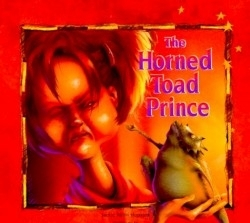The Horned Toad Prince
The original Brother’s Grimm tale, The Frog Prince, has here been remade into a rousing Southwestern tale with elements both fabricated and familiar.
Out on the lonesome prairie, Reba Jo is a live-wire cowgirl ready to lasso anything in her path. When her new hat blows down a dried-up old well she breaks down in despair. Enter the horned toad, fat and sassy, ready to retrieve her sombrero for just three small favors, some chili, a song and a nap in the hat. She agrees, only to immediately ride off once her hat is returned. Later, good ole Dad puts her back in line, “When you strike a bargain in these parts, a deal’s a deal.”
It turns out our wily toad has one last trick up his sleeve. In a departure from the original tale he makes yet another deal with Reba Jo. “Give me a kiss…and I’ll be on my way pronto.” Reba Jo complies, allowing for the miraculous transformation. Now, wanting the Horned Toad Prince to stay, Reba Jo recollects a story she once heard. “Aren’t we supposed to get hitched and ride off into the sunset?” But the cabellero, or gentleman, finally has the upper hand and reminds her, a deal’s a deal! While the text ends somewhat abruptly at this point, with the Toad Prince saying adios, the illustrations have one more piece of storytelling to add. In a fitting connection back to the beginning of the tale, we see Reba Jo’s lasso ready to haul that smug prince back. It seems the clever toad has met his match!
This book boasts a strong Southwestern setting that positively influences the text. The lively retelling is seeped in Southwestern vernacular and location specific accoutrements, from Reba Jo’s exclamation, “Dadburn it!” to chili for lunch. Spanish words are used throughout, appearing in italics. They are seamlessly explained within the text plus a useful Spanish-English glossary is included. Richly hued illustrations add to the books raucous flavor. Using dusty mustard yellows and a splattering of rust, the scenes look dry and windswept. Each drawing is uniformly framed with a frayed rope-like border with characters and objects often spilling outside of this loose boundary. Changing perspectives are prevalent, as such, they never really give a good clear sense of the characters appearance. It’s hard to tell, for instance, if Reba Jo’s a young girl or a woman. Instead, contortions of face and body are a window into the characters’ exaggerated personalities.
As with any folk retelling, it’s fun to be familiar with the original version in order to make comparisons of both plot and character but it’s also important that the new version stand on its own literary merits. This book allows for illuminating connections to the Grimm text while recreating the main characters in a way that’s consistent with this truly American setting. With this retelling it’s clear, no two creatures were ever better suited to each other.
Disclosure: This article is not an endorsement, but a review. The publisher of this book provided free copies of the book to have their book reviewed by a professional reviewer. No fee was paid by the publisher for this review. Foreword Reviews only recommends books that we love. Foreword Magazine, Inc. is disclosing this in accordance with the Federal Trade Commission’s 16 CFR, Part 255.

